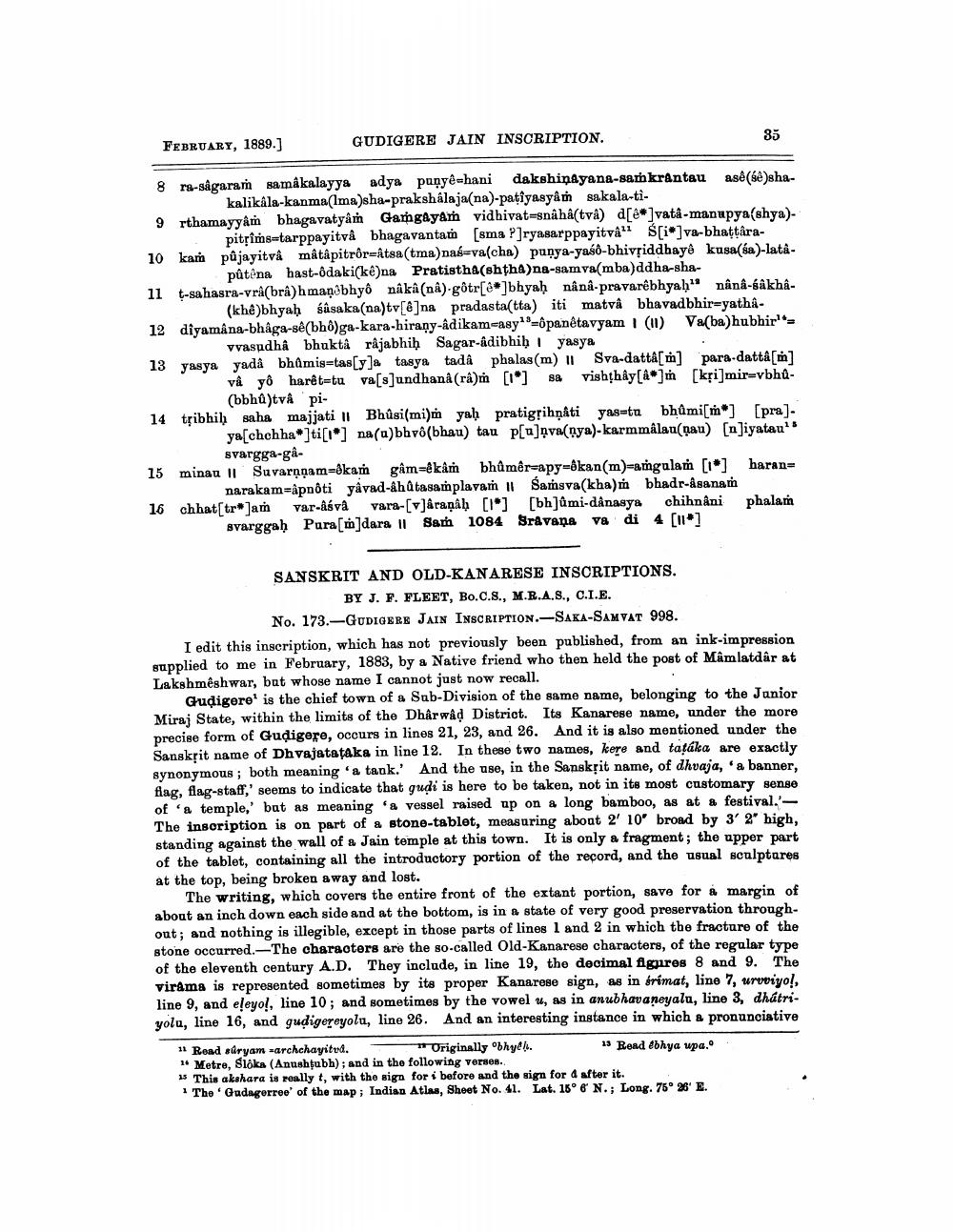________________
FEBRUARY, 1889.)
GUDIGERE JAIN INSCRIPTION.
8 ra-sågaram samåkalayya adya punye-hani dakshinayana-samkrantau asé(se)sha
kalikala-kanma(Ima)sha-prakshålaja(na)-patiyasyâ sakala-ti9 rthamayyâm bhagavatyam Gamg&yam vidhivat=snâhâ(två) d[e]vatâ -manupya(shya).
pitsims-tarppayitvå bhagavantar (sma P]ryasarppayitva"? $[io]va-bhattara10 kam půjayitvå måtâpitrôr=Atsa(tma)naš=va(cha) punya-yaśô-bhivriddhayê kusa(sa)-latá
pûtena hast-Odaki(ke)na Pratistha(shtha)na-samva(mba)ddha-sha11 t-sahasra-vrå(brâ)hmaṇabhyô nâkâ(nâ)-gôtr[*]bhyaḥ nânâ pravarêbhyah" nânâ-sakha
(khô)bhyah sasaka(na)tv[@]na pradasta(tta) iti matva bhavadbhir-yath12 diyamâna-bhaga-sê(bhô)ga-kara-hirany-adikam-asy*=ôpanētavyam 1 (11) Vasba)hubhir
vvasudha bhuktà râjabhiḥ Sagar-âdibhihi yasya 13 yasya yada bhômisetas[y]a tasya tada phalas(m) II Sva-datta[m] para-datta[m]
vê yê harêt=tu va[s]undhana (râ) [1] sa vishțhảy[á]m [kri]mir=vbhû
(bbhů)två pi14 tạibhih saha majjati | Bhúsi(mi) yah pratigrihņti yasata bhůmi[mo] (pra).
ya[chchhalti[io] na(a)bhvô(bhau) tau p[u]ņva(nya)-karmmålau(nau) [n]iyatau's
svargga-gå15 minau | Suvarņņam=8kam gâm=@kam bhûmêr=apy=ôkan(m)=amgalam [] haran=
narakam-apnôti yavad-&hâtasamplavam 11 Sansva(kha) bhadr-âsanam 16 chhat(tr* Jan var-âśva vara-[v]åraņâh [1] [bh]ůmi-dậnasya chihnâni phalam
svarggah Pura[n]dara 11 Sam 1084 Sravana va di 4 [11]
SANSKRIT AND OLD-KANARESE INSCRIPTIONS.
BY J. F. FLEET, Bo.C.S., M.R.A.S., C.I.E.
No. 173.-GUDIGERE JAIN INSCRIPTION.-SAKA-SAMVAT 998. I edit this inscription, which has not previously been published, from an ink-impression supplied to me in February, 1883, by a Native friend who then held the post of Mamlatdâr at Lakshmêshwar, but whose name I cannot just now recall.
Gudigere' is the chief town of a Sub-Division of the same name, belonging to the Junior Miraj State, within the limits of the Dharwad District. Its Kanarese name, under the more precise form of Gudigere, occurs in lines 21, 23, and 26. And it is also mentioned under the Sanskrit name of Dhvajatataka in line 12. In these two names, kere and tatáka are exactly synonymous; both meaning 'a tank. And the use, in the Sanskrit name, of dhvaja, a banner, flag, flag-staff,' seems to indicate that gudi is here to be taken, not in its most customary sense of a temple,' bat as meaning "a vessel raised up on a long bamboo, as at & festival.'-- The inscription is on part of a stone-tablet, measuring about 2' 10' broad by 3' 2' high, standing against the wall of a Jain temple at this town. It is only a fragment; the upper part of the tablet, containing all the introductory portion of the record, and the usual sculptares at the top, being broken away and lost.
The writing, which covers the entire front of the extant portion, save for å margin of about an inch down each side and at the bottom, is in a state of very good preservation throughout; and nothing is illegible, except in those parts of lines 1 and 2 in which the fracture of the stone occurred. -The characters are the so-called Old-Kanarese characters, of the regular type of the eleventh century A.D. They include, in line 19, the decimal figures 8 and 9. The virama is represented sometimes by its proper Kanarese sign, as in frímat, line 7, urwiyo!, line 9, and eleyo!, line 10; and sometimes by the vowel , as in anubhavaneyala, line 3, dhátriyola, line 16, and gudigereyolu, line 26. And an interesting instance in which a pronunciative 11 Road saryam -archchayitva.
Originally hydr.
13 Read #bhya wpa. 14 Metre, Slóka (Anushţubh); and in the following verses. 15 This akshara is really t, with the sign for i before and the sign for d after it. 1 The.Gadagerree of the map; Indian Atlas, Sheet No. 41. Lat. 16° N.; Long. 75° 26' E.




